The Alibaba Cloud 2021 Double 11 Cloud Services Sale is live now! For a limited time only you can turbocharge your cloud journey with core Alibaba Cloud products available from just $1, while you can win up to $1,111 in cash plus $1,111 in Alibaba Cloud credits in the Number Guessing Contest.
Every year's Double 11 Shopping Festival is an astonishing, record-breaking day in terms of logistics. Every year, our system is capable of handling millions upon millions of parcels all at once thanks to big data, AI, machine learning, and collaboration at various levels of our system. This entire process has been accelerated over the years with overall efficiency improved. Just consider these numbers recorded from 2013 to 2016. For the Double 11 event in 2013, it took nine days for one hundred million parcels to be delivered to recipients, but this was reduced to six days in 2014, four days in 2015, and only three and a half days in 2016.
As a platform, at Cainiao, our job is not just about maintaining delivery vehicles and personnel. Rather, we have a vision to become a social logistics and supply chain company with the help of big data and related technologies. In reality, Cainiao has been working diligently to achieve this goal over the past few years, and a lot of hard work has been put into enriching all our logistics operations. Through this hard work and diligence, we've made many breakthroughs. We can now accurately predict the numbers of parcels and direction where they will be going during major promotion events like Double 11. We can also maintain more reasonable stocks and warehouse distribution figures based on our own intelligent forecasts, and achieve a system for pre-packaging products ahead of order placements.
In this article, we will be looking into how Alibaba's Smart Logistics Network of Cainiao had prepared for this year's "battle of billions of parcels" during the big Double 11 shopping festival through the power of big data and related technologies like machine learning algorithms and AI based on our own home-grown and in-house technological explorations and practices in parcel prediction, warehousing, the involvement of more branches in order processing, order routing, and scheduling, as well as electronic express bills, intelligent order allocation, and end-parcel handlers.
During the big Double 11 promotion event in 2015, we saw an historic surge in the number of parcels to be delivered to Alibaba e-commerce customers. The number was 467 million, which was a 65% growth over just the year before. This was again set to be followed by yet another explosive increase in 2016, at which time the number came close to the one billion mark for that year's Double 11. So, as you can see, providing information that express courier companies need for preemptive planning on how to handle the massive load of Double 11 deliveries was of considerable importance. Therefore, in 2016, this necessary information was supplied and also realized through big data prediction, which helped to estimate the total number of parcels as well as predict the flow and direction of all parcels. Of course, all of this represents a huge yet crucial technological breakthrough and the challenge it overcame.
Our prediction for the total number of parcels was based on an estimation for the gross merchandise volume (GMV) of the current year's Double 11 event, as well as the GMV data and logistic order statistics in previous years, and the price trends for daily sales and major promotions in the past. Our prediction also considered several macro-economic factors in addition to the monitored sales data analytics of Alibaba's various e-commerce platforms. We even weighted in several other possible uncertainties. All of this effort, in the end, paid off as it guaranteed a robust prediction for the growth margin of the total number of parcels in 2016. The final estimate put the number of parcels at 680 million for the 2016 Double 11 event, which so happened to have just a 3% error from the actual recorded number of parcels.

The estimated 680 million parcels were precisely divided and allocated to different express courier companies, cities, and along different routes. Furthermore, based on schedule prediction, the number of parcels to be handled every day on each route and the upcoming parcels during Double 11 was also estimated, which helped the involved express courier companies have the necessary trucks and scheduling staff ready, and optimize resources to handle the peak load of logistics with ease.
In this big data prediction model, Cainiao extracted useful information from the sales data of six million stores over the past five years and predicted the express courier companies, warehouses, and cities that consumers were likely to choose during Double 11. We determined the delivery addresses consumers that were likely to use based on the recorded consumer behaviors. We could also forecast the market shares of different express courier companies during the Double 11 Shopping Festival based on such factors as their involvement and capacity. Following this, the regression prediction model we used to factor in all relevant information helped us estimate the number of parcels handled by different express courier companies along all the various routes throughout China three months ahead of Double 11, with an 80% accuracy rate. This was useful for express courier companies to get resources ready before the "true battle" began.
In preparation for Double 11, the storage of hundreds of millions of products from thousands of manufacturers in hundreds of warehouses in an orderly fashion is an equally immense challenge. The delivery and arrival of so many products in such a short time generally tends to overwhelm the capacity of warehouses, with the warehouse stock to be unable to catch up with orders. And, the reality is that problems like these kept popping up.
Before the Double 11 big event in 2016, Cainiao's coordinated warehousing platform established a big data platform to link together information throughout the entire warehousing process from the initial appointment to the completion of warehousing. Basic statistics related to stores, roads, carriers, drivers, routes, vehicles, and the size of products was widely weighed in as some of the factors involved in Cainiao's operational algorithm. This algorithm was in charge of deducing the actual available warehouse space and remaining warehouse space available during Double 11. The calculation results, combined with the prepared resources and the layered data of manufacturers and products, laid the important foundation for the intelligent recommendation for warehousing for a successfully diversified and coordinated reservation of relevant warehousing. Hundreds of millions of parcels were put into stock in an orderly and sequenced fashion, without overwhelming the warehousing capacity or keeping the vendors waiting too long.

To make sure that prepared resources accurately matched the reserved demand of vendors, sales and operations planning (S&OP) played a prominent role on the warehousing end. The system used Cainiao's big data algorithms to predict the number of parcels moving in and out of the warehouses and analyzed the estimated number of parcels going in and out of warehouses before and after Double 11 in previous years. The data was disclosed to the relevant warehouses, as well as the relevant distribution and transportation systems in advance. This was to guarantee resource readiness both in the upstream and downstream channels through a multi-role, multi-layered coordination effort.
In addition, Cainiao has taken things a step further by storing products in localities and regions that are closest to the potential customers to give customers the best possible logistics experience. And, by considering such factors as the historical sales data analytics of various third-party vendors, the social warehouse distribution network, the timeliness of delivery routes, and overall costs, Cainiao is capable of recommending the optimal products warehousing plan and the inventory distribution plan through its big-data real-time operation simulation system. As a piece of this overall picture, direct data transmission to the replenishment system ensures that products are distributed to the warehouses that are the closest to consumers.
By linking the data of different stages of the entire warehousing system, Cainiao can guarantee that the customer needs, vendor appointments, and resource preparations of warehouses are matched in the actual supply and demand of the event. And, at the same time, Cainiao can also maintain an optimal distribution of products in warehouses in an orderly fashion through recommended warehouse selection and allocation, the big-data appointment platform, and S&OP. All of this is another contribution of Cainiao to the logistics world, showing how these systems can help get the most out of data for the coordination of social resources.
Naturally, in the overall parcel delivery process, the top concern of customers tends to be the time that the delivery person will knock at their door. In addition to directly storing products in the warehouses that are the nearest to each one of our customers, Cainiao continuously provides advice and finds new means of moving products closer to customers in a more intelligent and efficient manner. This, of course, is to achieve the vision of "getting products pre-packaged before orders are placed."
But, on further consideration, you may have a questions in your mind. For example, which products are the most likely to be purchased? Which ones are most likely to be bought in combination with each other? And how many products or product combinations will be sold during large promotions like Double 11?
Cainiao has worked hard over the years to get closers and closer to the exact figures needed, and the precise answers to these questions before a major promotion event like Double 11 or Tmall's 6-18. And through big data analytics and related machine learning algorithms, together with the distribution statistics of product stocks and the historical data analytics of orders and deliveries, as well as the related shopping cart and favorites data of e-commerce shoppers, the order structure of vendors during Double 11 can be predicted to an extremely low error percentage. This allows warehouses to pre-package products to prepare them for delivery at any time, which then helped them to save loads of time in the actual production and packaging stages.

The front-end warehouses and branches throughout China are crucial components of Cainiao's warehousing and distribution network. Following the calculation of the estimated sales data, the automatic allocation system starts. In this stage, the system gives automatic allocation and loading suggestions, based on such factors as the estimated sales quantity, the stock in different distribution systems, missing products, turnover status, timeliness, and costs. Products are collectively distributed to warehouses or branches in advance.
For the reverse situation, Cainiao is also well prepared. The big data algorithm-based risk model used by Cainiao rates the refunding possibility according to consumer profiling, products profiling, and refunding model. Highly risky orders are not included in prior distribution to widespread sites, and only low-risk ones are. This achieves the optimal balance between efficiency and cost.
The number of parcels during the Double 11 Shopping Festival typically increases to 10 times or even dozens of times the number in off-peak periods. The prediction, overall planning, preemptive packaging, allocation, and widespread distribution based on big data algorithms make full use of valuable days ahead of Double 11 to significantly speed up overall parcel turnover and improve the consumer experience.
Double 11 in 2016 was on a Friday, which meant that many parcels would be delivered on the following Saturday and Sunday. But delivery sites in core regions of China were and are limited, could have easily be overwhelmed by the Double 11 traffic, which is typically five-times the number of parcels processed during normal working periods. That is, of course, if no effective measures are taken to handle the surge in workload.
Besides the issues mentioned above, deliveries to commercial areas and office buildings are rarely signed for on weekends, which means that weekend deliveries to these places may be wasteful in terms of manpower and resources. Therefore, typically, by delaying such deliveries to the following workdays, pressure during peak periods can be partially relieved, avoiding wasting resources caused by repeated deliveries.
In part by analyzing the geographic database of Amap, Alibaba's mobile map app, and Cainiao's massive well of delivery data, Cainiao was able to establish a machine learning model whose accuracy and office address returning rate are both over 95%. This was also established based on the signing receipt cycle, the distribution of people who use public addresses, and POI, the address recognition technology allows Cainiao to flexibly control when to package and deliver orders to an office address, which significantly lowers the chance of an "overwhelmed warehouse".
Compared with the previous year, the number of cross-border delivery parcels generated in the export businesses of AliExpress, Alibaba's cross-border e-commerce platform, and in the import businesses of Tmall handled during 2016 Double 11 both doubled. Behind Alibaba's exponential growth of the number of international parcels, the selection of the right carrier and route for each parcel to optimize the cost, timeliness, and service of each parcel is commercially valuable and technically challenging.
Cross-border logistics features long distances, long channels, and multiple roles, resulting in high logistics costs for each delivery, which accounts for a high percentage of the overall price per customer. Cainiao has been working since 2015 on the technical means for how to solve routing issues to achieve optimal selection. Recently, Cainiao decided to take an approach that is based on human involvement and big data intelligence.
The human involvement strategy's dynamic rule engine mechanism allows operators to customize the routing strategy and perform selective filtering based on their own experiences and parcel attributes. The big data top-out approach conducts machine learning processes based on the historical records of parcel delivery, selecting the optimal route of each parcel in consideration of the dimensions of cost, timeliness, and service quality, to achieve smart routing in a real sense of the word.
Cainiao's Global Routing Center (GRC) has been a big boost to business performance since its launch. In the course of three to four months, GRC enabled AliExpress to shorten the delivery of their parcels to the top 20 Russian cities from 25 days to 15 days, and deliveries to other European countries and the US also sped up by around 20%. Cainiao helps vendors reduce the transportation costs by more than 15% because it selects the optimal routes based on the category, weight, and size of delivered products. In terms of service, Cainiao's export logistics service was ranked in the leading group of Chinese export e-commerce platforms one year after it was launched, according to vendor surveys and DSR ratings.
Registering and printing conventional hard-copy express bills will only become even more inefficient as vendors deliver increasingly more parcels. In addition, hard-copy express bills cannot guarantee efficient communications among vendors, express courier companies, and Cainiao. This is not helpful for the informatization of logistics and further technological optimization. In 2014, Cainiao rolled out the electronic express bill service, which made deliveries much more efficient. Big data-based technologies such as intelligent order allocation help logistics companies more efficiently operate distribution centers and branches.

Cainiao Electronic Express Bill is an online waybill generation, printing, and management service system. The system can print express bills of 15 mainstream domestic express courier companies, a number of landing delivery companies, and plenty of international logistics companies. Cainiao has opened this service to all third-party vendors, and it is connected with more than 300 mainstream ISV systems. The electronic express bill system has many hubs, with each hub enabling smooth information flow among vendors, Cainiao, and express courier companies.
Based on Cainiao's electronic express bills, we can offer unified express bills to vendors. Vendors or independent software vendors (ISVs) just need to link with Cainiao to use the electronic express bills of courier companies.
In addition, Cainiao has cooperated with major courier companies to design standard express bill templates, which significantly standardizes and simplifies the template format, including the bill size and the formatting of content. We also developed the express bill printing tools, formulated and made open Cainiao's printing standards, to ensure that all the express bills printed in Cainiao's express bill system have the same format.
Electronic express bills make Cainiao a carrier for different logistic services and a great help to third-party express courier companies. The widely used two-segment code and three-segment code can help Cainiao's big data order allocation system locate the corresponding collection branch, end distribution center, end delivery branch, and the handler of every parcel in real time. This means that, whenever an express bill is generated, the routing of the parcel throughout its lifecycle is already planned and calculated, making parcel handling much more efficient.
During previous major promotion events, the warehouses of express courier companies were frequently overwhelmed. However, during the Double 11 promotion in 2016, with a record-breaking number of 650 million parcels to be delivered, news about warehouse overload was rare. So how did this happen?
Numerous parcels are sorted out in distribution centers and express branches before they are delivered to customers. In the past, handlers sorted out parcels based on the address information on the express bills. Relying on human memory can easily go wrong under the huge load of numerous addresses, and some parcels can therefore be delivered to wrong routes. Therefore, handlers need at least half a year's training before they can start working on the job. Therefore, the manual sorting piece of the puzzle is the efficiency bottleneck when the number of parcels surges during major promotion events such as Double 11, which can result in frequent warehouse overloading.
To tackle this problem, Cainiao's algorithm team designed the big data-powered intelligent order allocation system, known as "three-segment code". This system can accurately predict the code of delivery branches and parcel handlers, and print the code on the express bill to facilitate subsequent sorting operations. With intelligent allocation, handlers can directly and more efficiently distribute parcels according to codes on the express bills with a 99.9% accuracy rate. Eliminating the reliance on sorting handlers also reduces the labor cost of courier companies. This system is already connected to mainstream express courier companies in China, which has helped them save over RMB 600 million in labor costs for them.
Last year, Cainiao launched the "two-segment code" to help allocation centers quickly sort out parcels, which was a major success. Cainiao went a step further in 2016 Double 11 by releasing the three-segment code solution that includes delivery persons in the prediction and allows branches to quickly assign parcels to them.
Cainiao can precisely send each and every parcel to the most appropriate delivery person. Similar to the two-segment code, delivery person information is also printed on the three-segment code express bills. In the end branches, delivery persons no longer select parcels according to the address information on the bills, but can quickly sort out parcels based on the printed "three-segment code" on the express bills.
In 2016 Double 11, "three-segment code" was crucial in helping courier branches quickly sort out and deliver parcels. Temporarily employed parcel sorting staff can quickly get started without lengthy and complicated training. Veteran sorting staff no longer need to carefully read and remember every address. The three-segment code simplifies the sorting operations and makes sorting more efficient by saving 2.4 seconds on average when processing a parcel. A parcel stayed in the courier branch for a whole hour shorter during 2016's Double 11 compared to the previous year's event. This translates into a total of 160,000 hours saved for parcel handlers in delivering parcels.
Based on electronic express bills and intelligent order allocation, mainstream courier companies extensively used automatic allocation devices in 2016, significantly improving the parcel handling efficiency in key nodes. This is why consumers feel that parcel deliveries in Double 11 have accelerated.

For the final collection and delivery of parcels, every parcel handler usually takes charge of POIs with natural boundaries, such as communities, schools, factories, industrial parks, and office buildings. Parcel handlers bring together parcels from the same place. This way, handlers can collect and deliver parcels basically along a straight route.
Parcels are collected together for delivery, which significantly shortens the length of the delivery route by avoiding frequently bypassing natural obstacles, such as trunk roads, overhead bridges, rivers, walls, or hills. This makes it more efficient for delivery persons to collect and deliver parcels.
Here is the typical work day of a delivery person: The delivery person carries a full load of parcels and sets off from the branch office in the morning, opens the parcel delivery app that advises of the destination communities, schools, and office buildings of the parcels, signs for receipt, verifies parcels, discovers the available courier cabinets (through cabinet data aggregation), and sends notifications to recipients. The aggregated parcel information can be used to calculate the optimal delivery route in real time. A delivery person now can do much more each day than before.
Parcels to be delivered to places that are not far from each other, such as those locations in the same community, school, or office building, are combined together to form an order cluster and be assigned to one delivery person. If an order is received but has not been collected yet, new orders from nearby places are directly added to the order list of the delivery person who can then take the order.
By combining and adding orders, parcels can be collected in batches, saving time and increasing the overall income of the delivery persons employed. During the Double 11 Shopping Festival, parcels of combined and added orders account for 40% of total parcels.
The system can dynamically judges a delivery person's current position and next destination based on the changing status of parcels in the delivery list. Then the system can directly assign parcels to be delivered out of the current place or the next destination to the delivery person, increasing their income.
The task of handling millions upon millions of parcels and packages during every Double 11 is immense. However, in response to this challenge, Cainiao has worked hard and diligently to continue to improve efficiency and optimize and streamline services through innovative solutions that are powered by data intelligence and machine learning. These solutions are implemented at all stages and all fields of the parcel delivery process. And through an improved supply chain solution, as well as better order scheduling and intelligent order allocation systems, Cainiao has been able to provide smooth and reliable technical support and superior services to thousands upon thousands of customers during every year's Double 11.

2,593 posts | 792 followers
FollowAlibaba Clouder - January 22, 2020
Alibaba Clouder - May 13, 2021
Alibaba Clouder - January 2, 2020
Apache Flink Community China - September 27, 2020
Alibaba Clouder - January 2, 2020
Richard Kou - February 20, 2021

2,593 posts | 792 followers
Follow Platform For AI
Platform For AI
A platform that provides enterprise-level data modeling services based on machine learning algorithms to quickly meet your needs for data-driven operations.
Learn More Data Transmission Service
Data Transmission Service
Supports data migration and data synchronization between data engines, such as relational database, NoSQL and OLAP
Learn MoreMore Posts by Alibaba Clouder